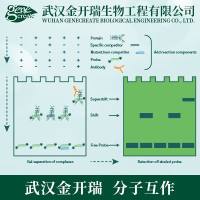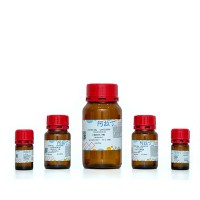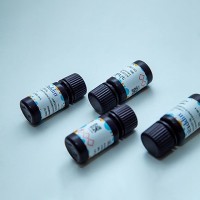【共享】3i胶体金经典文献1-快速一步法免疫层析检测技术的发展
丁香园论坛
1248
http://www.3i.com.cn/article/07.htm
Development of Rapid One-Step Immunochromatographic Assay
(快速一步法免疫层析检测技术的发展)
~undefinedGraduate School of Biotechnology and †Department of Chemistry, Korea University,
5-ka, Anam-dong, Sungbuk-ku, Seoul 136-701, Korea
发布者:派坤学苑
发布时间:2006-5-10
--------------------------------------------------------------------------------
An analytical system for a one-step immunoassay has been constructed using the concept of immunochromatography.
The system employed two different antibodies that bound distinctepitopes of an analyte molecule: an antibody labeled with a signalgenerator (e.g., colloidal gold), which was placed in the dry stateat a predetermined site on a glass-fiber membrane, and anotherantibody immobilized on the surface of a nitrocellulose membrane.Three membranes, one with the tracer, one with immobilizedantibody, and a cellulose membrane as the absorbent of medium (in a sequence from the bottom), were attached to aplastic film and cut into strips. Aqueous medium containing analyteabsorbed from the bottom end of the immunostrip dissolvedthe labeled antibody, and the antigen–antibody binding complexformed was transported into the next nitrocellulose membrane bythe flow caused by capillary action. The complex subsequentlyreacted with the immobilized antibody, which generated a signal in proportion to the analyte concentration. The convective masstransfer of the immunoreactant to the binding partner allowed theassay to be performed with no handling of reagents. The reaction,however, was carried out under nonequilibrium conditions, whichresulted in decreased sensitivity as compared with assays performedin an equilibrium mode (e.g., ELISA). To minimize suchsacrifice, major factors that control system performance were identified and the system was then devised under optimal conditions.
一个用于一步免疫检测的分析系统已经用免疫层析原理构造出来了。在这个系统中用到能结合到一个分析物分子的不同抗原决定基的两个不同的抗体:一个抗体用信号产生物(如胶体金)标记,在干燥的情况下放置在一个玻璃纤维膜上预定的位置;另一个抗体则固定在一个硝酸纤维素膜的表面。这里有三个膜粘在塑胶胶片上并割成条状,一个放有追踪物,一个固定抗体,最后一个纤维膜用于吸收介质溶液(从底部依次顺序)。含有分析物的水溶液从免疫条的底端吸收并溶解了标记抗体,然后合成的抗原-抗体复合物在毛细作用力的驱动下流到下一个硝酸纤维素膜。随后复合物将与固定化的抗体反应,产生的信号和分析物的浓度成比例。免疫反应物对流传递到固定化的抗体,这使得不需要操作反应物就能进行检测。然而,反应是在非平衡态的条件下进行的,这导致其灵敏度相比较在平衡态(如ELISA)的检测效果而言要差。为了减少这种损失,先确认控制系统性能的主要因素,然后在最优条件下设计系统。
(全文较长,并有图,这里发表不了,详情请见 http://www.3i.com.cn/article/07.htm)
Development of Rapid One-Step Immunochromatographic Assay
(快速一步法免疫层析检测技术的发展)
~undefinedGraduate School of Biotechnology and †Department of Chemistry, Korea University,
5-ka, Anam-dong, Sungbuk-ku, Seoul 136-701, Korea
发布者:派坤学苑
发布时间:2006-5-10
--------------------------------------------------------------------------------
An analytical system for a one-step immunoassay has been constructed using the concept of immunochromatography.
The system employed two different antibodies that bound distinctepitopes of an analyte molecule: an antibody labeled with a signalgenerator (e.g., colloidal gold), which was placed in the dry stateat a predetermined site on a glass-fiber membrane, and anotherantibody immobilized on the surface of a nitrocellulose membrane.Three membranes, one with the tracer, one with immobilizedantibody, and a cellulose membrane as the absorbent of medium (in a sequence from the bottom), were attached to aplastic film and cut into strips. Aqueous medium containing analyteabsorbed from the bottom end of the immunostrip dissolvedthe labeled antibody, and the antigen–antibody binding complexformed was transported into the next nitrocellulose membrane bythe flow caused by capillary action. The complex subsequentlyreacted with the immobilized antibody, which generated a signal in proportion to the analyte concentration. The convective masstransfer of the immunoreactant to the binding partner allowed theassay to be performed with no handling of reagents. The reaction,however, was carried out under nonequilibrium conditions, whichresulted in decreased sensitivity as compared with assays performedin an equilibrium mode (e.g., ELISA). To minimize suchsacrifice, major factors that control system performance were identified and the system was then devised under optimal conditions.
一个用于一步免疫检测的分析系统已经用免疫层析原理构造出来了。在这个系统中用到能结合到一个分析物分子的不同抗原决定基的两个不同的抗体:一个抗体用信号产生物(如胶体金)标记,在干燥的情况下放置在一个玻璃纤维膜上预定的位置;另一个抗体则固定在一个硝酸纤维素膜的表面。这里有三个膜粘在塑胶胶片上并割成条状,一个放有追踪物,一个固定抗体,最后一个纤维膜用于吸收介质溶液(从底部依次顺序)。含有分析物的水溶液从免疫条的底端吸收并溶解了标记抗体,然后合成的抗原-抗体复合物在毛细作用力的驱动下流到下一个硝酸纤维素膜。随后复合物将与固定化的抗体反应,产生的信号和分析物的浓度成比例。免疫反应物对流传递到固定化的抗体,这使得不需要操作反应物就能进行检测。然而,反应是在非平衡态的条件下进行的,这导致其灵敏度相比较在平衡态(如ELISA)的检测效果而言要差。为了减少这种损失,先确认控制系统性能的主要因素,然后在最优条件下设计系统。
(全文较长,并有图,这里发表不了,详情请见 http://www.3i.com.cn/article/07.htm)








